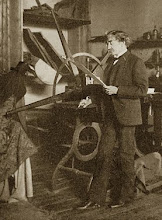
Almost every time I search through the various etching and printmaking forums for new posts of interest there are entries from new artists asking for advice on how to get started, what equipment to buy, basic technique, and how to make adjustments or troubleshoot problems. I can relate to these inquiries because I’m very new to the art myself, having begun my printmaking journey only a little over a year ago.
I haven’t had the opportunity to take a printmaking class though I’ve taken specialty courses from time to time in my own profession of cabinetmaking. Those classes were helpful and in some cases invaluable and I’m glad I participated. The key to those meaningful experiences and the advice I would offer to those etching and printmaking beginners seeking answers to basic or advanced questions, advice I followed and continue to follow myself is just this: read the classics.
Gaining a firm historical, technical, and philosophical understanding of those who have gone before us will immeasurably enhance one's time spent at work in the classroom or in your personal studio. This includes studying the works of acknowledged masters, their techniques, and even their habits and lifestyles to get an idea of their aesthetics and what moved and motivated them. It will help you discover what moves and motivates you and allow you to express to a higher degree what it is you want to say in your medium. While the great etchers of history had natural talent, they also had years of technical training and practice and were highly adept technically in handling their equipment and materials. Much can be learned by trial and error but it would be a foolish waste of time not to inform that practical, hands-on learning process by wringing as much advantage as possible from the many lessons they have left us in their lives and work.
I’ve listed below the books I’ve collected over the last year or so and described them briefly with some words as to how they may be helpful. Most can be found used at places like Ebay or Alibris, some are Google books that can be downloaded for free. This is not an exhaustive list by any means but these have been the most helpful for me. I’ve listed them in an order that I think might be the best if one has the option of having them all at once and the luxury of reading them in a particular order. I did not acquire them or read them that way however so starting with the one that sounds most interesting may be the way to go.
Practical Guide to Etching and Other Intaglio Printmaking Techniques by Manly Banister, 1969. – This is not by one of the “old masters” but is a good, basic book written in a modern way and can be used as a studio handbook very easily. Some of the older books can be a little slow going in their writing style for more modern tastes so this may be the place to get a working overview of the equipment and processes. I personally value the older works more since extremely talented artists wrote them during the great etching revival of the late 19th and early 20th centuries. As such they have much to offer but Banister is a talented, knowledgeable artist and this helpful book will get you going and whet your appetite for more.
Etching and Etchers by Phillip Gilbert Hamerton, 1868. – This is the oldest book on the list and not necessarily the best. Its information is sound and was in many ways the bible of the etching revival and is often referenced by other writers of the period. It is a valuable reference and a great preparation for those planning to read the works that followed.
Etchers and Etching by Joseph Pennell, 1919. – This is perhaps my favorite. Joseph Pennell and his wife authored many books. Pennell especially had strong views on etching, etchers, and artists and the art world in general. He was also a master at illustration, etching, lithography, and pen and ink. This book is in my opinion essential reading for every etcher. People seem to ask around $50 for this book but if you are persistent you can get it for much less. I got a nice, oversize first edition hardcover for $12 on Alibris. Buy and read this book!
Pennell’s New York Etchings: 90 Prints by Joseph Pennell; Text by Edward Bryant, 1990. – This would be a good time to focus on the art itself and though Pennell in his book discusses many examples, his own are not only magnificent but illustrate what he was trying to get across in his book. There’s also a brief but excellent introduction that gives Pennell’s biography with details on his technique, etc. My goal is to one day own one of his etchings!
The Art of Etching by E. S. Lumsden, 1924. – After the justifiably opinionated but invaluable Pennell, take a break with this book. He gives a very thorough discussion of materials and technique as well as some insights into other etchers and their work. An easy read with great nuggets of information scattered throughout. Among other things you will learn how to mix all different kinds of mordants for every kind of work or experiment like the “old timers” did it. You’ll be surprised how you can affect the biting in different ways.
The Printing of Etchings and Engravings by David Strang, 1930. – This is a somewhat uncommon book but has some particularly valuable explanations on paper, press setup, and of course printing. It has a somewhat less valuable, in my opinion, section on wiping the plate by his own scientific method that may put you to sleep faster than Sominex. But it is worth having and reading for all that.
How To Make Etchings by John J. Barry, 1929. – Written by one of the offspring of those who began the etching revival in the 19th century. How sad that at the time this book was written, etching was already starting to fade slightly as an artistic medium in the “art world”. This is a short but nice little handbook on basic process. Not essential but a good read. It also helps that I have an original, signed etching from the author in the original frame with an exhibition tag from 1937! The price at the time was $8.00.
Palaces in the Night: Whistler in Venice by Margaret F. McDonald, 2001. – Whistler is the Master. Some say he is better than Rembrandt; virtually no one rates him less. He brought impressionism to etching and changed everything. His work in other mediums is well known. His biography by Joseph and Elizabeth Pennell is well worth reading. This is a great newer book about his time in Venice when he was under commission to do etchings for the Fine Arts society of London. He worked in other mediums during that period as well and the author describes and illustrates them all with special emphasis on his etchings. She describes his technique, methods of work, and includes letters and other references. It is an invaluable and insightful book from which a surprising amount of helpful technical knowledge can be learned.
With Whistler In Venice by Otto H. Bacher, 1909. – Last but by no means least is this book by a man who worked with and was friends with Whistler during the latter’s stay in Venice. Bacher was also an etcher and had his own press that Whistler used to make proofs of the work be was doing. His book is a great read and has all sorts of interesting antidotes, and tidbits about there life in Venice, Whistler’s methods and work habits, etc. Not a journal but very personal in its descriptions and content. The book is available as a reprint through Alibris and is worth the purchase.
Selected Etchings of James A. McN. Whistler, Selected and Illustrated by Maria Naylor, 1975. – Obviously no look at Whistler can be complete without looking at his etchings. Examples abound in the other books above but these represent a wide selection and many inspirational, beautiful examples, most printed full-sized.
I left the Whistler books to last only because the focus of them is more specialized on a single individual as opposed to etching in general. But they are no less valuable for filling out the historical picture and giving the work we do today some context. They also contain plenty of meat and food for thought that can be directly applied to our work today that may in the end usher in a whole new etching revival.
These are not the only books out there, but frankly I find in general the older works much more informative than the newer. In some ways they are more basic while at the same time being more complete and thorough. In any case, I hope you will take advantage of them as I have and that they will help you as they have helped me.





















+With+Press+cropped.jpg)


